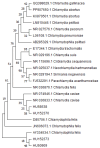The Occurrence of Chlamydia felis in Cats and Dogs in Hungary
- PMID: 39338962
- PMCID: PMC11434856
- DOI: 10.3390/pathogens13090771
The Occurrence of Chlamydia felis in Cats and Dogs in Hungary
Abstract
The World Health Organization (WHO) estimates that many human infections are zoonoses, creating a worldwide public health challenge. Among Chlamydia species, Chlamydia felis is the leading cause of conjunctivitis in cats and is a prominent zoonotic species. This study aimed to determine the occurrence and risk of chlamydiosis in cats and dogs in Szeged, Hungary, and surrounding areas. The total nucleic acids from conjunctival swab samples of symptomatic and asymptomatic animals were extracted using an automated nucleic acid extraction system. After that, DNA was amplified by pan-chlamydia PCR. Bacterial and fungal cultures were also performed to detect other microorganisms. Of the 93 animals, 32 (34.4%) were positive for pan-chlamydia PCR. The positivity rates were 33.3% (26/78) in cats and 40.0% (6/15) in dogs. Furthermore, the positivity rates were 37.2% (16/43) in the cat shelter, 42.4% (14/33) in the veterinary clinic, and 11.7% (2/17) in household pets. In total, 103 species were identified through culture-based examinations, including 97 (94.2%) bacterial and 6 fungal (5.8%) species. From both human and animal health perspectives, it is essential to have a detailed understanding of the circumstances of chlamydiosis, given the global impact of zoonotic diseases.
Keywords: Chlamydia felis; animal health; chlamydiosis; one health; zoonotic diseases.
Conflict of interest statement
The authors declare no conflicts of interest.
Figures
References
-
- World Health Organization Zoonoses. [(accessed on 21 June 2024)]. Available online: https://www.who.int/news-room/fact-sheets/detail/zoonoses.
MeSH terms
LinkOut - more resources
Full Text Sources
Medical
Miscellaneous


